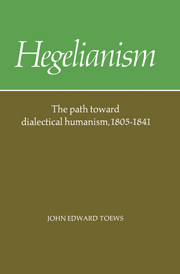Book contents
- Frontmatter
- Contents
- Preface
- Introduction: the Hegelian project in ideological perspective
- PART I PHILOSOPHY AND CULTURAL INTEGRATION: HEGEL IN CONTEXT
- PART II THE HISTORICAL APPROPRIATION OF THE ABSOLUTE: UNITY AND DIVERSITY IN THE HEGELIAN SCHOOL, 1805–1831
- PART III THE REDUCTION OF THE ABSOLUTE TO “MAN”: THE DIVISION OF THE SCHOOL AND THE EMERGENCE OF THE HEGELIAN LEFT, 1830–1841
- 7 Right, Center, and Left: the division of the Hegelian school in the 1830s
- 8 Strauss and the principle of immanence
- 9 Bruno Bauer and the reduction of absolute spirit to human self-consciousness
- 10 Feuerbach and the reduction of absolute spirit to human “species being”
- EPILOGUE: BEYOND “MAN” – THE RISE AND FALL OF LEFT HEGELIAN HUMANISM
- Notes
- Bibliography
- Index
7 - Right, Center, and Left: the division of the Hegelian school in the 1830s
Published online by Cambridge University Press: 08 January 2010
- Frontmatter
- Contents
- Preface
- Introduction: the Hegelian project in ideological perspective
- PART I PHILOSOPHY AND CULTURAL INTEGRATION: HEGEL IN CONTEXT
- PART II THE HISTORICAL APPROPRIATION OF THE ABSOLUTE: UNITY AND DIVERSITY IN THE HEGELIAN SCHOOL, 1805–1831
- PART III THE REDUCTION OF THE ABSOLUTE TO “MAN”: THE DIVISION OF THE SCHOOL AND THE EMERGENCE OF THE HEGELIAN LEFT, 1830–1841
- 7 Right, Center, and Left: the division of the Hegelian school in the 1830s
- 8 Strauss and the principle of immanence
- 9 Bruno Bauer and the reduction of absolute spirit to human self-consciousness
- 10 Feuerbach and the reduction of absolute spirit to human “species being”
- EPILOGUE: BEYOND “MAN” – THE RISE AND FALL OF LEFT HEGELIAN HUMANISM
- Notes
- Bibliography
- Index
Summary
During the 1830s the divergent tendencies that had emerged within the Hegelian school during the 1820s became more obvious and more extreme. But disagreements among Hegelians concerning the relationship between the science of the absolute and the existing political and religious reality produced a division of the school into opposing factions only when they evolved into divergent interpretations of the very core of the Hegelian inheritance: the dialectical identity of finite and infinite, thought and being, subject and substance, in the selfactualizing, self-comprehending, concrete totality of absolute spirit. The publication of Strauss's Life of Jesus in 1835-6 marked the beginning of self-conscious disagreement on this latter, more fundamental issue, and it was Strauss himself, in response to the reception of his work by other Hegelians, who first divided the school into factions of Right, Center, and Left. The most dramatic and significant development in the history of Hegelianism during the 1830s was the shift from divergent interpretations of the relationship between theory and practice to conflicts over the meaning, and ultimately the validity, of Hegelian theory, the beginnings of what Marx later satirically described as the “putrescence of the absolute spirit.”
Rosenkranz was one of the first Hegelians to realize that the proliferation of opposing positions within Hegelianism was leading to a decomposition of Hegelianism itself. In 1840 he published a comic drama in which the problem of “succession” within the school, of finding a legitimate heir to Hegel's throne, was made the object of gentle satire and humorous caricature. Immediately after Hegel's death the inner circle of his disciples had denied that a problem of “succession” existed.
- Type
- Chapter
- Information
- HegelianismThe Path Toward Dialectical Humanism, 1805–1841, pp. 203 - 254Publisher: Cambridge University PressPrint publication year: 1981



